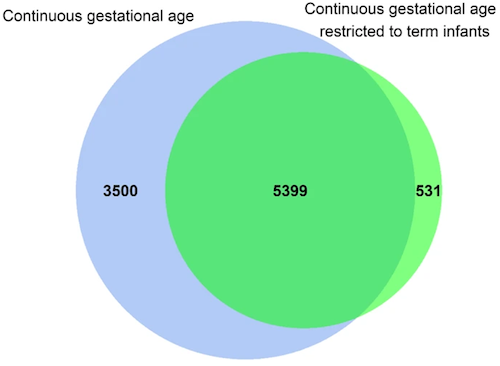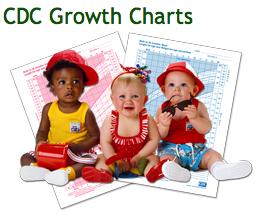|
|
Developmental Biology - DNA Methylation
Length of Pregnancy Alters a Child's DNA
With each additional week of pregnancy, DNA methylation changes thousands of genes...
Researchers from Karolinska Institutet in Sweden, an international team, have genetically mapped more than 6,000 newborn births and established a relationship between length of pregnancy and increase in methylation changes. For each additional week of pregnancy, thousands of DNA methylation changes were detected in umbilical cord blood. The study is published in Genome Medicine.
Premature birth, any birth before 37 consecutive weeks' of pregnancy, is not uncommon. Between 5 and 10% of all children in the world are born prematurely. Most will develop and grow normally, but premature birth can also be linked to respiratory and lung disease, eye problems and neurodevelopmental disorders.
During the fetal period, epigenetic processes — chemical modifications to DNA — are important for controlling development and growth. One such epigenetic factor is methylation, which affects gene activation and therefore how much of a particular protein is formed.
"Our new findings indicate these DNA changes may influence the development of fetal organs."
Simon Kebede Merid, first author and PhD student at Karolinska Institutet, Department of Clinical Science and Education, Södersjukhuset, Sweeden.
The majority of observed DNA methylations at birth tend not to persist into childhood. But in 17% of births followed in this study, methlation levels were completely stable from birth through adolescence - thus methylation levels persisted with age.
"Now we need to investigate whether these DNA changes are linked to health problems in those born prematurely."
Erik Melén PhD, Professor, Department of Clinical Science and Education, Södersjukhuset; Institute of Environmental Medicine, Karolinska Institutet, Stockholm, Sweden; Sachs’ Children’s Hospital, South General Hospital, Stockholm, Sweden; shared senior author with Stephanie J. London.
Epigenetics is the study of how genes, environment and health link together. Research conducted by the international Pregnancy and Childhood Epigenetics (PACE) consortium, represents contributions from 26 studies on this topic worldwide. Erik Melén's group has previously contributed to PACE research reflecting mother's smoking habits during pregnancy and DNA changes observed in their newborns. In two other PACE studies, Melen's group reported the affects of air pollution on newborn health.
"We hope our new findings will contribute valuable knowledge about fetal development. And in the long term, new opportunities for better care of premature babies — to avoid birth complications and adverse health effects."
Erik Melén PhD
Abstract
Background
Preterm birth and shorter duration of pregnancy are associated with increased morbidity in neonatal and later life. As the epigenome is known to have an important role during fetal development, we investigated associations between gestational age and blood DNA methylation in children.
Methods
We performed meta-analysis of Illumina’s HumanMethylation450-array associations between gestational age and cord blood DNA methylation in 3648 newborns from 17 cohorts without common pregnancy complications, induced delivery or caesarean section. We also explored associations of gestational age with DNA methylation measured at 4–18 years in additional pediatric cohorts. Follow-up analyses of DNA methylation and gene expression correlations were performed in cord blood. DNA methylation profiles were also explored in tissues relevant for gestational age health effects: fetal brain and lung.
Results
We identified 8899 CpGs in cord blood that were associated with gestational age (range 27–42 weeks), at Bonferroni significance, P < 1.06 × 10- 7, of which 3343 were novel. These were annotated to 4966 genes. After restricting findings to at least three significant adjacent CpGs, we identified 1276 CpGs annotated to 325 genes. Results were generally consistent when analyses were restricted to term births. Cord blood findings tended not to persist into childhood and adolescence. Pathway analyses identified enrichment for biological processes critical to embryonic development. Follow-up of identified genes showed correlations between gestational age and DNA methylation levels in fetal brain and lung tissue, as well as correlation with expression levels.
Conclusions
We identified numerous CpGs differentially methylated in relation to gestational age at birth that appear to reflect fetal developmental processes across tissues. These findings may contribute to understanding mechanisms linking gestational age to health effects.
Authors
Simon Kebede Merid, Alexei Novoloaca, Gemma C. Sharp, Leanne K. Küpers, Alvin T. Kho, Ritu Roy, Lu Gao, Isabella Annesi-Maesano, Pooja Jain, Michelle Plusquin, Manolis Kogevinas, Catherine Allard, Florianne O. Vehmeijer, Nabila Kazmi, Lucas A. Salas, Faisal I. Rezwan, Hongmei Zhang, Sylvain Sebert, Darina Czamara, Sheryl L. Rifas-Shiman, Phillip E. Melton, Debbie A. Lawlor, Göran Pershagen, Carrie V. Breton, Karen Huen, Nour Baiz, Luigi Gagliardi, Tim S. Nawrot, Eva Corpeleijn, Patrice Perron, Liesbeth Duijts, Ellen Aagaard Nohr, Mariona Bustamante, Susan L. Ewart, Wilfried Karmaus, Shanshan Zhao, Christian M. Page, Zdenko Herceg, Marjo-Riitta Jarvelin, Jari Lahti, Andrea A. Baccarelli, Denise Anderson, Priyadarshini Kachroo, Caroline L. Relton, Anna Bergström, Brenda Eskenazi, Munawar Hussain Soomro, Paolo Vineis, Harold Snieder, Luigi Bouchard, Vincent W. Jaddoe, Thorkild I. A. Sørensen, Martine Vrijheid, S. Hasan Arshad, John W. Holloway, Siri E. Håberg, Per Magnus, Terence Dwyer, Elisabeth B. Binder, Dawn L. DeMeo, Judith M. Vonk, John Newnham, Kelan G. Tantisira, Inger Kull, Joseph L. Wiemels, Barbara Heude, Jordi Sunyer, Wenche Nystad, Monica C. Munthe-Kaas, Katri Räikkönen, Emily Oken, Rae-Chi Huang, Scott T. Weiss, Josep Maria Antó, Jean Bousquet, Ashish Kumar, Cilla Söderhäll, Catarina Almqvist, Andres Cardenas, Olena Gruzieva, Cheng-Jian Xu, Sarah E. Reese, Juha Kere, Petter Brodin, Olivia Solomon, Matthias Wielscher, Nina Holland, Akram Ghantous, Marie-France Hivert, Janine F. Felix, Gerard H. Koppelman, Stephanie J. London and Erik Melén.
Acknowledgements
The Swedish part of the study was funded by the European Research Council (TRIBAL, grant agreement 757919), the Swedish Research Council, the Heart Lung Foundation, the Stockholm Region (ALF, and for the BAMSE project), and SFO Epidemiology, Karolinska Institutet.
Return to top of page.
| |
|
Mar 20 2020 Fetal Timeline Maternal Timeline News
 Overlap between Bonferroni-significant CpG sites from two different analyses after exclusion of maternal and delivery with induction or caesarean section (“no complication”). BLUE represents the continuous gestational age main model, and GREEN represents the continuous model restricted to term only. Overlap of findings alters the color. CREDIT Karolinska Institutet
|



